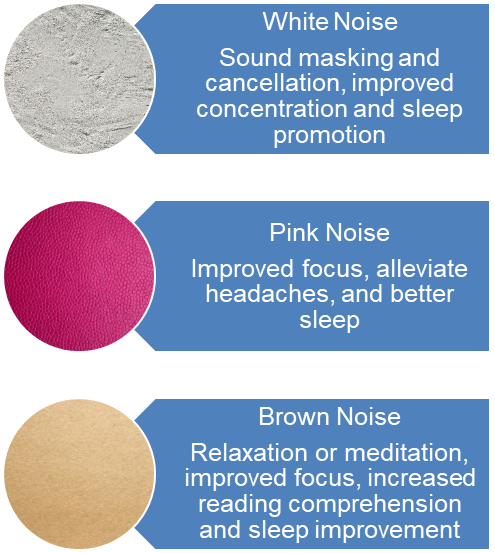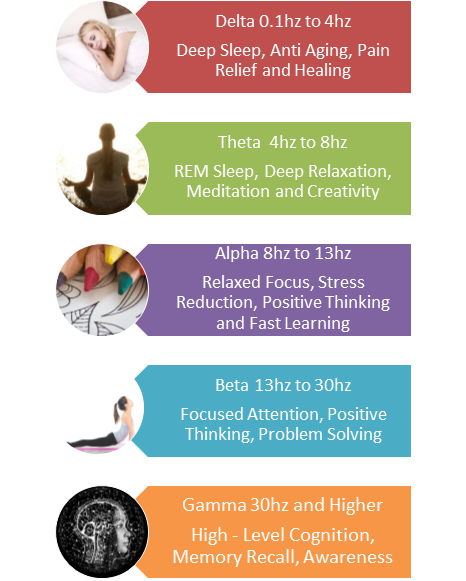When creating mind/body fitness classes, we are never told which type of music is most useful or how to appropriately choose our music. An instructor will usually choose music for the sound that is pleasing to them. There is nothing wrong with this, and in fact, music is very subjective to everyone. Not everyone will like the same music that is chosen for the class. Some class participants may ask where you purchased your music, but you cannot please everyone with the music selection. You may be wondering how the brain picks up these frequencies and synchronizes them with its brainwaves. The brain can differentiate each sound frequency as it enters the brain through the ear. You may not know, however, that each frequency has it’s own specific purpose. For example, white noise is commonly used for helping individuals to get to sleep as well as calm the sound of Tinnitus (a ringing in the ears). Once you understand how frequencies work you can choose music that will produce a certain outcome. (National Institutes of Health, 2018)

Music and Stress
According to the University of Nevada, music can be a powerful stress reliever as well as help the mind to be more focused. (4) Choosing the right type of music for each class is critical in helping you to achieve the objective of somatic movement classes. It is known, for example, that faster music can make participants feel upbeat and be better able to concentrate. A slower beat can help you to quiet the mind and your class participant to de-stress. The University of Nevada says that music that is 60 beats per minute can cause the brain to synchronize with the beat, causing alpha brain waves to initiate. This relates to sound frequencies that are 8-14 hertz or cycles per second. Alpha brainwaves are present when we are relaxed and conscious. Delta brainwaves are dominant at 5 hertz. Stanford University found that certain sounds tend to relax us more; they are Native American, Celtic, Indian stringed instruments, drums, and flutes. There is a song called “Weightless” by Marconi Union, which is said to be the most relaxing song in the world. They ask that you not listen to it while driving in the car. The specific purpose of the song is to help lower the heart rate, reduce blood pressure, and reduce levels of the hormone cortisol. You can play the song on YouTube for a thoroughly relaxing experience and then record how you felt in your journal. It is noted that individuals should listen to this type of music for at least 45 minutes to obtain full benefits.
Psych Central says that nature sounds are very beneficial in decreasing stress levels because of the external focus it provides. When playing nature sounds for somatic movement classes, you want to use real sounds of nature. Artificial sounds draw the participant into themselves and can have the opposite effect. Listening to nature for 30 to 40 minutes three times a week can profoundly decrease stress and cortisol levels. (5) When choosing music for the Mindful Stretch or NeuRoll Calm™ class, we ask that you use primarily natural sounds mixed with soft music. Isochronic tones can be used as well, depending on the goal of the class you are instructing. (3)

Nature sounds help you to focus internally
Nature and soundscapes are widely used for meditation, but the question is which sounds are best for our group exercise class or small group training sessions. As the instructor, you are setting the objective for each class, and you can choose the music accordingly. Both of these types of music have frequencies or noise colors, and each color can be used to elicit specific meditative responses. The colors are white noise, pink noise, blue noise, grey noise, violet noise, red noise, green noise, and black noise. According to audiology.com, the most common noise colors used in meditation are white noise, pink noise, and brown noise. You can tell the difference in the noises by listening to them one at a time. White noise has a higher frequency and is perceived to be louder than it is; think of a water fountain. Pink noise has a more resonant sound than white noise and has more of a balanced sound; an example would be a calm ocean, and brown noise sounds like a soft rumble like thunder or a rough ocean. (2)
White noise is a collective frequency of all noise and can block out or mask other sounds. Some individuals use a fan, for example, to help them fall asleep at night. White noise is the go-to sound for masking sounds that come from within. Tinnitus sufferers use white noise to mask the constant sounds in their ears. Tinnitus can sound like a heartbeat, swooshing noise, or many other sounds within the ear. Other benefits of white noise are improved concentration and sleep promotion. (2)
Pink noise is a popular alternative to white noise, and some individuals prefer it because of the more gentle, relaxing sound it makes. We recommend changing up the music because not everyone will always like the music you choose. Like white noise, pink noise also includes the whole sound spectrum, but it has a less harsh sound. An example of pink noise is rushing water or heavy rain. Pink noise is also used to block out other sounds and help with improved focus, alleviating headaches, and promoting sleep. (2)
Brown noise was actually discovered by Robert Brown, a botanist in the 1800s, who calls this Brownian Motion. Brown takes the low frequency of pink noise lower, so it sounds like a buzz. Brown noise sounds like rushing water with a low roar. Brown noise is used to help with relaxation or meditation, improved focus, and reading comprehension, as well as sleep promotion. This is also known as Brown noise because the change in sound signal is random.(2)
Noise Color Chart

Adapted from: Gulf Coast Audiology. “White, Pink or Brown: Which Noise Helps You Sleep Better? – Hearing Aids Hearing Loss: Pascagoula: Biloxi, Mississippi: Gulf Coast Audiology.” Hearing Aids Hearing Loss | Pascagoula | Biloxi, Mississippi | Gulf Coast Audiology, 10 Feb. 2016,
Binaural Beats
Binaural beats are another type of music that can be used by clients at home or whenever they feel stressed. The sound produced is relaxing as long as the hertz or cycles per second are within the right cycle per sound. Individuals usually listen to binaural beats through earphones to achieve the best outcome. Each ear typically has a different frequency than the brain is listening to. The frequency should be no more than 30 hertz apart for the brain to synchronize the soundwave. The only known side effect of binaural beats, when listened to through headphones, is seizures. If anyone chooses to listen to binaural beats on their own with headphones, it is recommended to consult with their physician first. If you are using binaural beats in class, it does not have the same effect. It is relaxing, but the brain can only synchronize the sound and pick up brainwaves through earphones. For now, we know that binaural beats can help with anxiety, memory, mood, creativity, and attention. The different brain waves are Delta, Theta, Alpha, Beta, and Gamma. Delta brainwaves are synchronized with a hertz of 0.1 to 4, Theta brainwaves are noticed at 4 to 8 hertz, Alpha is 8 to 13 hertz, Beta is 13 to 30 hertz, and Gamma is 30 hertz and higher. (1)
Psychology Today says that individuals have decreased cortisol, increases in melatonin, and decreases in DHEA when listening to binaural beats. This therapy is also being looked into as a possible treatment for anxiety and pain reduction. It is essential to stay within the hertz ranges that are provided below. If you go higher than the recommended Herz range, the individual could end up with the opposite effect of what the goal for the class originally was. For example, someone who is looking for stress relief could become anxious instead. Music that pre-mixed already follows these guidelines. (1)
Isochronic Tones
Isochronic tones are single notes of tones that are spaced evenly to create a rhythmic beat type of sound. You do not need to wear earphones for Isochronic tones to be useful as they are a singular beat, and the brainwaves produced can be measured by an EEG test. Many Isochronic tones are mixed with soft music or nature sounds. According to Healthline, Isochronic tones may promote better quality sleep, focus, and attention, decrease pain, help with declining memory, meditation, and a more positive mood. Isochronic tones follow the same brainwaves as Binaural Beats. It is recommended to use isochronic tones when instructing mind/body classes. (1)
Binaural Beats and Isochronic Tone Brain Waves Chart

Adapted from: Booth, Stephanie. “Brain Health With Binaural Beats”. Healthline, Healthline Media, 14 May 2019.
The music for class should be either natural soundscapes with soothing music blended with it or Isochronic Tones-based, which you can find online. Isochronic tones can be sold as a full album or a single song. We suggest starting the music before class to help calm class participants and prepare them for Mindful Stretch™. The instructor should also use a natural voice and no microphone. A natural voice helps to elicit the relaxation response and enables participants to connect with you. Keep in mind that breathing from the diaphragm helps instructors not to strain their vocal cords. The volume of the music being played is essential as well. It should be just loud enough that everyone can hear but soft enough that you can safely talk over the music. If you feel that you are straining your voice, lower the music to a level that is comfortable for you. (3)
Robyn Kade is the Founder of The Stress Management Institute for Health and Fitness Professionals. She has 20 years of experience in medical-based fitness.
References
- Booth, Stephanie. “Brain Health With Binaural Beats.” Healthline, Healthline Media, 14 May 2019,
- Gulf Coast Audiology. “White, Pink or Brown: Which Noise Helps You Sleep Better? – Hearing Aids Hearing Loss: Pascagoula: Biloxi, Mississippi: Gulf Coast Audiology.” Hearing Aids Hearing Loss | Pascagoula | Biloxi, Mississippi | Gulf Coast Audiology, 10 Feb. 2016.
- Kade, Robyn. Mind/Body Medicine Specialist Manual. 4th ed. / USA, Stress Management Institute for Health and Fitness Professionals, 2020.
- University of Nevada Reno. Releasing Stress through the Power of Music, 2020.
- Collingwood, J. “The Power of Music To Reduce Stress”. Psych Central, 2020.
